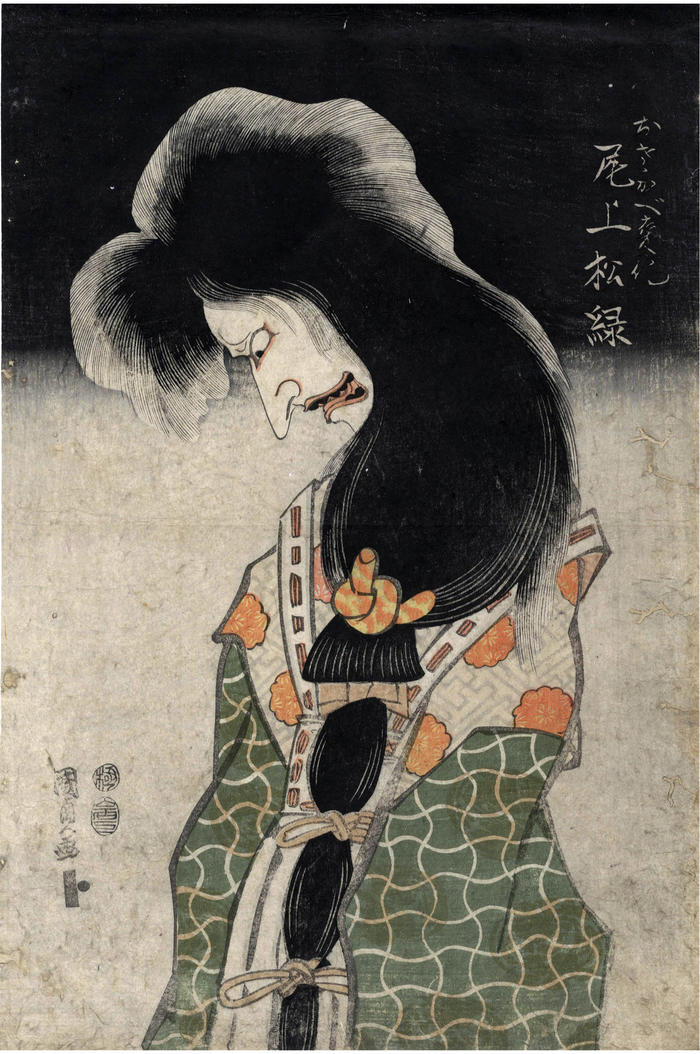Utagawa Kunisada (歌川国貞) / Toyokuni III (三代豊国) (artist 1786 – 01/12/1865)
Onoe Shōroku I (尾上松緑) as the ghost of Princess Osakabe (刑部姫) haunting Hayakawa Takakage on the battlements of Himeji Castle (姫路城) - Osakabe henka Onoe Shōroku (おさかべ変化尾上松緑) - this is the top half of a vertical diptych
1814
10 in x 15 in (Overall dimensions) Japanese woodblock print
Signed: Kunisada ga (国貞画)
Publisher: Yamaguchiya Tōbei
(Marks 591 - seal 15-005)
Censors' seals: Iwato and kiwame
Ritsumeikan University - the full diptych in black and white
Royal Museums of Art and History, Belgium (via Cultural Japan) - the full diptych
Lyon Collection - the full diptych This print represents a scene from the play Matazoro Shōroku Osakabe banashi (Shōroku's Revival of the Story of Princess Osakabe - 復再松緑刑部話) staged in the fifth month of 1814.
****
"Onoe Shōroku (1744-1815) was famous as a performer of ghost roles. Here he appears as the sixteen-foot-high apparition of Princess Osakabe.... The part of Osakabe required a great deal of strenuous physical action, and the seventy-year-old Shōroku was criticized for taking it on when he was past his best. This spectacular scene was performed in 5/1814. It tells the story of the ghost of Princess Osakabe haunting the warrior Hayakawa Takakage at Himeji castle.
"One eyewitness account by a child included in a critique stated: 'I was so terrified [of the spectre] I tried to get away... It was awful not being able to escape because of the huge crowd."
Quoted from: Kunisada: Imaging Drama and Beauty by Robert Schaap, p. 75. This is accompanied by color reproduction of this diptych from the Royal Museum, Brussels.
"The play became one of the ten favorite plays of the Onoe family, compiled by Onoe Kikugorō V (1845-1903) during the Meiji period (1868-1912) in reaction to the so-called Eighteen Plays (Kabuki jūhachiban) established by Danjūrō VII as the repertory restricted to the Ichikawa family."
Quoted from Kunisada's World by Sebastian Izzard, p. 42..This is the first illustration to appear in this catalogue, albeit in black and white.
****
Illustrated:
1) in black and white in Kunisada's World by Sebastian Izzard, Japan Society, Inc., 1993, no. 1, page 42. The full diptych is shown. This example is from the Musées Royaux d'Art et d'Histoire, Brussels.
2) in color in Utagawa Kunisada: His World Revisited by Sebastian Izzard, Sebastian Izzard, LLC, 2021, no. 5, page 55. The full diptych is shown.
3) in color in Kunisada: Imaging Drama and Beauty by Robert Schaap, Hotei Publishing, 2016, p. 75. The full diptych is shown. This example is the same one from the Musées Royaux d'Art et d'Histoire, Brussels.
Yamaguchiya Tōbei (山口屋藤兵衛) (publisher)
actor prints (yakusha-e - 役者絵) (genre)
Yūrei-zu (幽霊図 - ghosts demons monsters and spirits) (genre)
Onoe Shōroku I (初代尾上松緑: 11/1809 to 10/1815) (actor)
Kakemono-e - 掛物絵 (genre)
